
|
|

November 30, 2007
Medium Trip '07, Part V: Des Moines
Over the course of 2007, your editor set foot in 20 of our 50 states, visiting broadcast facilities all along the way. And now that the season of travel has ended, it's time to settle back and begin recapping some of what we saw as we criscrossed this land of ours.
This week, we continue our recap of what we'll call "Medium Trip 2007," a 10-day family journey that began and ended in Chicago, taking in much of Iowa and a little of eastern Nebraska along the way, and in the process revisiting for the first time some of the territory from our original Big Trip back in 2001.
When we left off in our last installment, we were barreling east on I-80 late on a Sunday night, heading for an overnight stop in Des Moines and a Monday-morning rendezvous with one of America's great radio signals: the 50,000-watt clear channel WHO (1040).
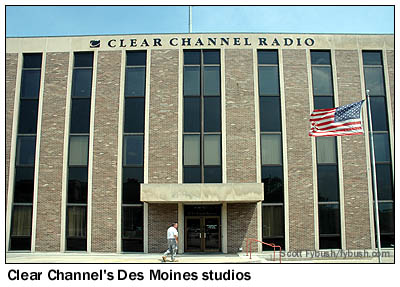
|
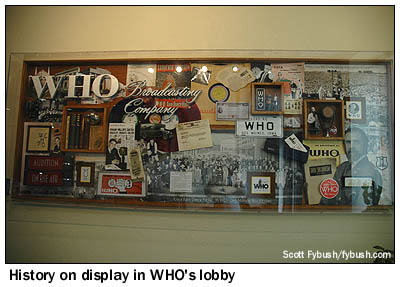
|
When we passed by WHO back in 2001, it and its Clear Channel Radio sister stations were operating out of a building on Grand Avenue shared with WHO-TV (Channel 13), which even then hadn't been co-owned with the radio stations for quite a few years.
In 2005, Clear Channel moved the stations a few blocks further out Grand Avenue from downtown, into a three-story building that used to house an insurance company. Sales and business offices take up the first two floors, just past the lobby display of WHO's long history. Upstairs, the top floor forms a ring of studios surrounding a central technical core.
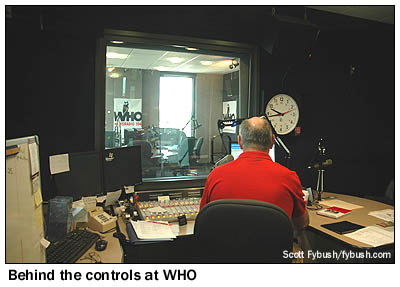
|
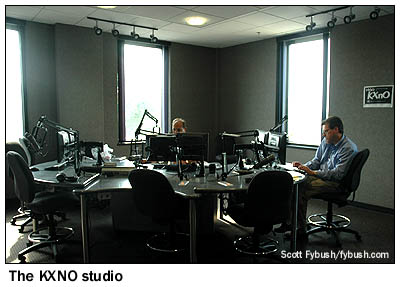
|
The two AM stations here take up the corners, with a suite for WHO on one end that includes a big corner talk studio, a master control room and a news studio and newsroom. (You'll probably see it on TV at some point or another over the next month, as candidates pass through en route to the Iowa caucuses.)
At the other end of the front of the building, there's a control room and spacious talk studio for Clear Channel's sports entry in town, KXNO (1460).
The three FM signals in the cluster operate out of smaller air studios and production rooms along the side hallways, relying heavily on automation and voicetracking for much of their schedules. WHO's historic FM sister at 100.3 is now playing adult hits (with a classic rock lean) as "The Bus," KDRB, complete with a bright green school bus remote vehicle parked out back. Two smaller signals fill out the cluster: AAA "Capital 106.3" KPTL (106.3 Ankeny) and top-40 "Kiss" KKDM (107.5 Des Moines).
(Clear Channel also owns two signals in Ames, 30 miles to the north. KASI 1430 and KCCQ 105.1 operate from a studio facility up there, but with engineering and back-office support from Des Moines.)
But we didn't come to Des Moines to see the studios, as comfortable as they are. We stopped here to add to our collection of inside visits to former class I-A clear channel transmitter sites, and with assistant chief engineer Rick Chalfant as driver and tour guide, we're soon headed out to Mitchellville, Iowa, 20 miles or so east (and a bit south) of Des Moines, to the majestic site that is the WHO transmitter facility.
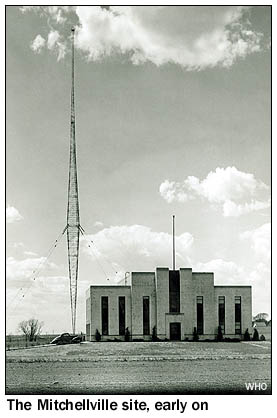 |
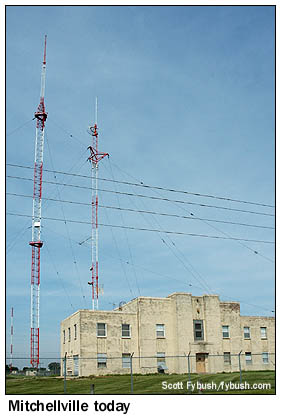
|
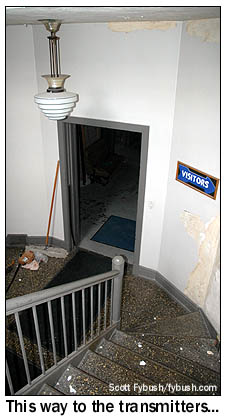 |
This site traces its history back to 1933, when Colonel B.J. Palmer, owner of stations WOC in Davenport and WHO in Des Moines, shut down his 5,000-watt transmitter sites in both cities (which had been operating synchronously at 1000 on the dial), replacing them with a new 50,000 watt facility at Mitchellville that identified, for a short time at least, as "WOC-WHO." Among the announcing staff back then was a young man named Ronald Reagan, who'd soon go on to bigger things.
The WOC calls soon disappeared, temporarily, from the airwaves, returning later in 1934 back in Cedar Rapids. WHO, meanwhile, quickly became one of the biggest stations in the nation, blasting its 50 kilowatts from an RCA transmitter through a 532-foot Blaw-Knox "diamond" style antenna out back.
That era of WHO history is mostly gone from the building out in Mitchellville, but the next era is still alive and well here. It was in 1950 that the Blaw-Knox tower was dismantled (its lower portion eventually ended up next to a State Police barracks in Des Moines), replaced with a 745-foot Franklin antenna topped out by antennas for WHO-TV (Channel 13) and WHO-FM (100.3).
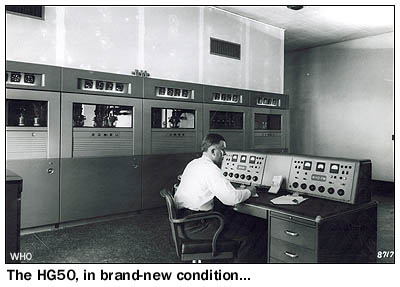 |
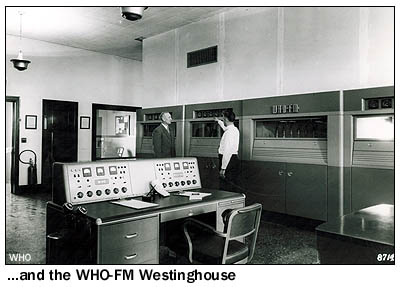 |
Inside the building, visitors were welcomed up the stairs (directed by a big blue "VISITORS" arrow on the wall!) to a grand transmitter hall, lined by a Westinghouse HG-50 on one side for WHO (by then moved from 1000 to 1040, as part of the 1941 NARBA shuffles) and by a Westinghouse FM transmitter on the other side. In the center sat - and still sits - a control desk with metering for both WHO and WHO-FM. (The latter was running 50 kW output power into a 12-bay antenna, which created a whopping 400 kW ERP; you can see more about the Westinghouse AM and FM transmitters over at the excellent desmoinesradio.com site.)
A TV transmitter went into the building in 1954, when WHO-TV signed on as Des Moines' first VHF station. (An earlier UHF entrant, KGTV on channel 17, soon went dark.)
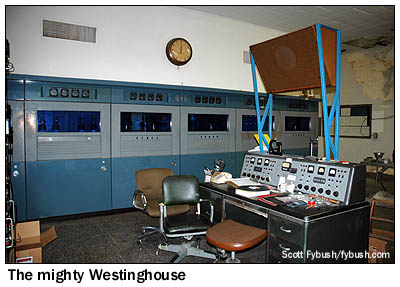
|
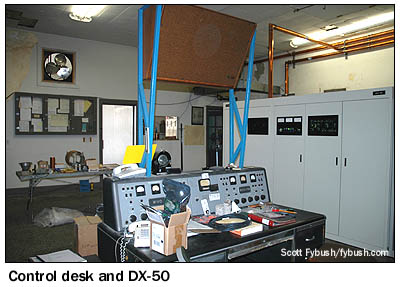 |
Where the FM transmitter, and later an RCA TV transmitter, once sat, there's now the station's current main transmitter, a Harris DX50 that went into operation in 1999. The station's previous main (and now backup), a Harris MW50, occupies a small room off to the side behind the DX50. Another small room on that side of the building looks to have once been used as an emergency studio.
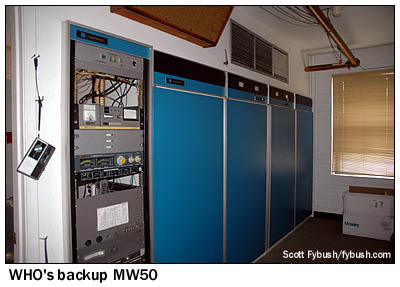
|
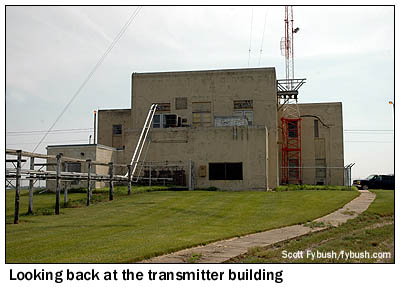
|
Behind the Westinghouse is a small apartment that's been used over the years by engineering staff. It was once the engineering manager's housing, while another set of rooms downstairs housed additional engineers back in the days when this site was manned.
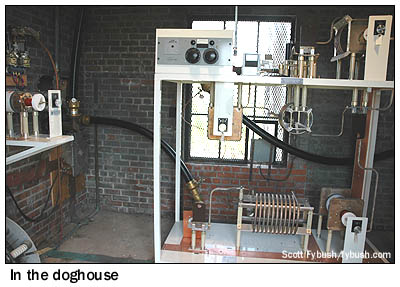 The
rest of the ground floor is all about power: transformers for
the big Westinghouse, as well as some remnants from the TV era
here and a spacious workbench area as well.
The
rest of the ground floor is all about power: transformers for
the big Westinghouse, as well as some remnants from the TV era
here and a spacious workbench area as well.
Shall we head out back to the towers? The transmission line is no longer open-wire, but it is still elevated as it exits the transmitter room for the short run back to the main tower and the longer run back to the 207-foot auxiliary tower at the rear of the property.
The tuning house at the base of the big tower sure looks to be original to the 1930s configuration here, though its innards certainly are not. (And we weren't going to stay in the vicinity of that wide-open ATU long enough to find out for sure!)
This being a Franklin antenna, the transmission line goes out the back of the tuning house, takes a bend and runs up the side of the tower to the 330-foot level, where it feeds the upper half of the tower.
(There's a great description of how the tower is configured, as well as more pictures of the place, over at Barry Mishkind's WHO site page at oldradio.com.)
At one time, of course, there would have been TV and FM transmission lines riding up the tower as well. Those went away sometime after 1973, when WHO joined forces with two other TV stations in the market to put up a 2000-foot monster of a tower in Alleman, north of Des Moines.
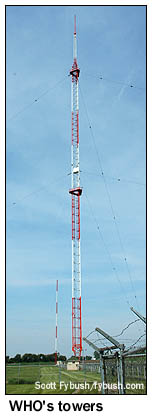
|
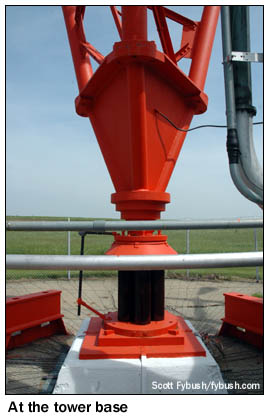
|
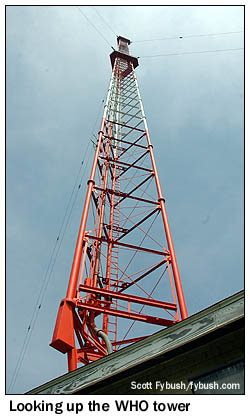
|
We'll check out that tall tower up in Alleman - and a few others in the neighborhood, too - in next week's installment. And in the meantime, you guessed it: you can hear legal IDs from WHO, and plenty of other Des Moines signals as well, next Wednesday at our sister site, Tophour.com.
Tower Site Calendar 2008 is here! Visit the Fybush.com Store now and get your calendar now!
- Previous Site of the Week: The Medium Trip 2007, part IV: Omaha
- Next Week: The Des Moines TV/FM Tower Farm, Alleman, IA
- Site of the Week INDEX!
- How can you help support Site of the Week? Click here!
- Submit your suggestions for a future Site of the Week!
